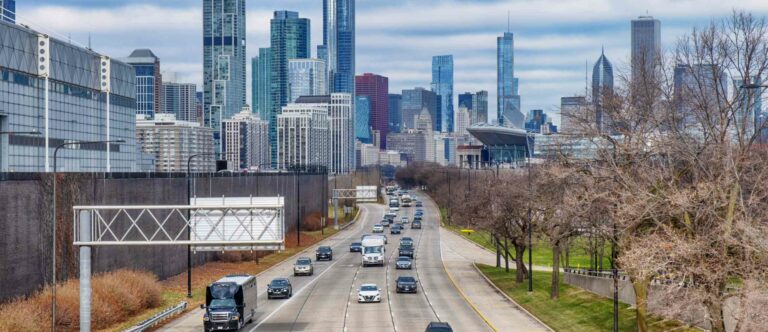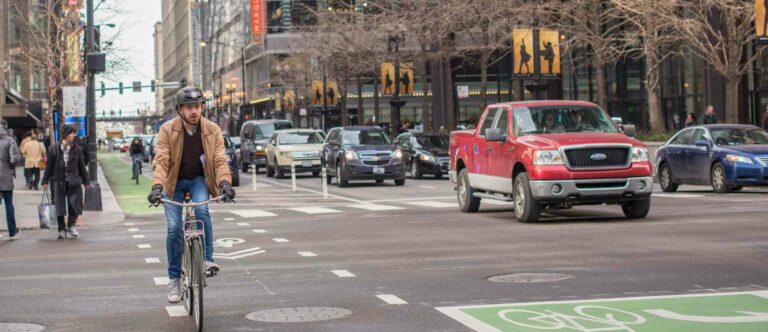The potential advent of self-driving trucks on Chicago’s bustling streets and highways like the Dan Ryan Expressway, DuSable Lake Shore Drive, to name a few, could be a game-changer for road safety and efficiency.
As technology advances, the potential for these autonomous commercial vehicles to reduce the risk of truck accidents, which often result in catastrophic injury or even wrongful death, is immense.
Yet, with this innovation comes a complex web of legal implications, from liability in accidents involving driverless trucks to evolving safety regulations.
And while the promise of machine learning to mitigate human error in truck drivers is captivating, the debate between human vigilance and algorithmic precision on the highway continues.
Keep reading to understand the transformative impact driverless trucks could have on transport and safety, and the legal challenges that need navigation. At Walner Law, our Chicago truck accident lawyers have the tools and experience you need if you are ever in an accident.
Exploring the Potential of Self-Driving Trucks for Safer Roads
The age of self-driving trucks promises a revolution in transport and a potential paradigm shift in road safety.
With advanced algorithms and the relentless pace of technological enhancements, these autonomous vehicles are poised to redefine the dynamics of commercial vehicle operation.
Skeptics question the readiness of such technology, yet proponents point to data suggesting significant safety improvements over traditional truck driver scenarios.
Our discussion continues by assessing how advancements in self-driving technology could contribute to safer travel on Illinois highways and beyond, while also reviewing statistical insights that hint at promising improvements in accident reduction.
Assessing the Advancement in Autonomous Vehicle Technology
The march toward fully autonomous vehicles has surged forward with quantum leaps in sensor and camera technology. These critical components enable trucks to perceive their surroundings with a precision that rivals, and in some instances surpasses, that of a human truck driver, thus mitigating the risks of accidents involving fatigue or distraction.
In Illinois, particularly within the bustling transport routes of Chicago, embracing these innovations means the potential to drastically lower accident statistics. The Illinois Department of Transportation is keeping a watchful eye on the evolving data, understanding that such technological integration could herald a significant dip in personal injury cases stemming from commercial vehicle incidents.
The Role of Machine Learning in Enhancing Truck Safety
As we venture further into the realm of vehicle automation, the role of machine learning emerges as a pivotal force in self-driving truck technology.
This computational intelligence not only absorbs vast quantities of data but also refines its capacity to detect and swiftly respond to potential hazards, effectively predicting and navigating through the unpredictability of road conditions.
The evolution of machine learning algorithms is at the core of autonomous truck safety, driving the future of transportation towards a horizon where accidents, traffic collisions, and human error are greatly minimized.
Understanding How AI Detects and Responds to Hazards
The revolution in transport technology has birthed vehicles with the cognitive prowess to detect impending road dangers. Self-driving trucks, equipped with sophisticated AI, meticulously scan their environment using an array of sensors, enabling real-time hazard identification — from a pedestrian unexpectedly stepping onto the road to the swift maneuvers of a vehicle cutting across lanes.
This vigilant AI operates like an omnipresent co-pilot, continuously monitoring for irregularities such as erratic driving patterns or potential collisions. Leveraging the power of predictive analytics, these systems can enact preemptive measures to safeguard passengers, pedestrians, and other road users, marking a proactive step towards enhancing road safety surrounding commercial vehicles.
The Evolution of Machine Learning in Vehicle Autonomy
The landscape of vehicle autonomy has undeniably been shaped by the progressive evolution of machine learning. This adaptive technology expertly navigates an intricate web of real-time traffic scenarios, continuously learning and enhancing its decision-making protocols, minimizing dangers on the road through ever-improving anticipatory actions.
At the heart of this progression lies the AI’s ability to transform vast amounts of traffic and sensory data into actionable insights, thus refining its predictive capabilities. Chicago’s highways and byways stand to undergo a transformative journey towards enhanced safety and efficiency as these autonomous systems approach a level of sophistication that could potentially outpace human reflexes and judgment.
Legal Implications Surrounding Autonomous Commercial Vehicles
As the landscape of transportation shifts towards autonomous commercial vehicles, the discussions within Chicago’s legal circles intensify. Safety is at the heart of the integration of self-driving trucks, necessitating a critical examination of current laws and future regulations.
Addressing these developments head-on, legal professionals are working to anticipate the landscape of a future where thoroughfares may be populated with driverless trucks.
Such preparation not only involves dissecting existing legislation but also crafting robust legal frameworks to support this groundbreaking transition in vehicle autonomy.
Navigating Through Current Laws and Regulations
As Chicago’s roads evolve to accommodate an era of self-driving technology, legal experts from a prominent Chicago law firm grapple with the intricacies that current legislation holds for autonomous commercial vehicles. Their focus sharpens on bridging the gaps in the existing framework, ensuring it aligns seamlessly with the novel set of challenges and scenarios presented by driverless trucks.
Regulatory bodies, guided by the specialized knowledge of Illinois lawyers, are actively assessing the spectrum of liability issues and insurance policies fundamental to the safe integration of these vehicles. This is a delicate dance toward safeguarding public interest without stifling the innovation that these autonomous systems bring to the bustling streets and highways of Chicago.
Predicting Future Legal Frameworks for Self-Driving Trucks
As anticipation builds around the introduction of autonomous trucks, Chicago personal injury lawyers like those at Walner Law are evaluating how traditional laws will adapt to technology’s edge. Their projections indicate that legislation must evolve to address unique considerations such as software liability, the delegation of control between human and machine, and the nuanced definitions of driver responsibility in the context of AI.
The dialogue at Chicago’s leading law firms is focused on the development of future legal frameworks that will undoubtedly need to reconcile advanced self-driving technology with practical regulation. It’s critical that these new laws offer clarity to protect all parties involved, from manufacturers down to the everyday road user, while fostering an environment that encourages continued innovation in autonomous transport.


 Skip to content
Skip to content







